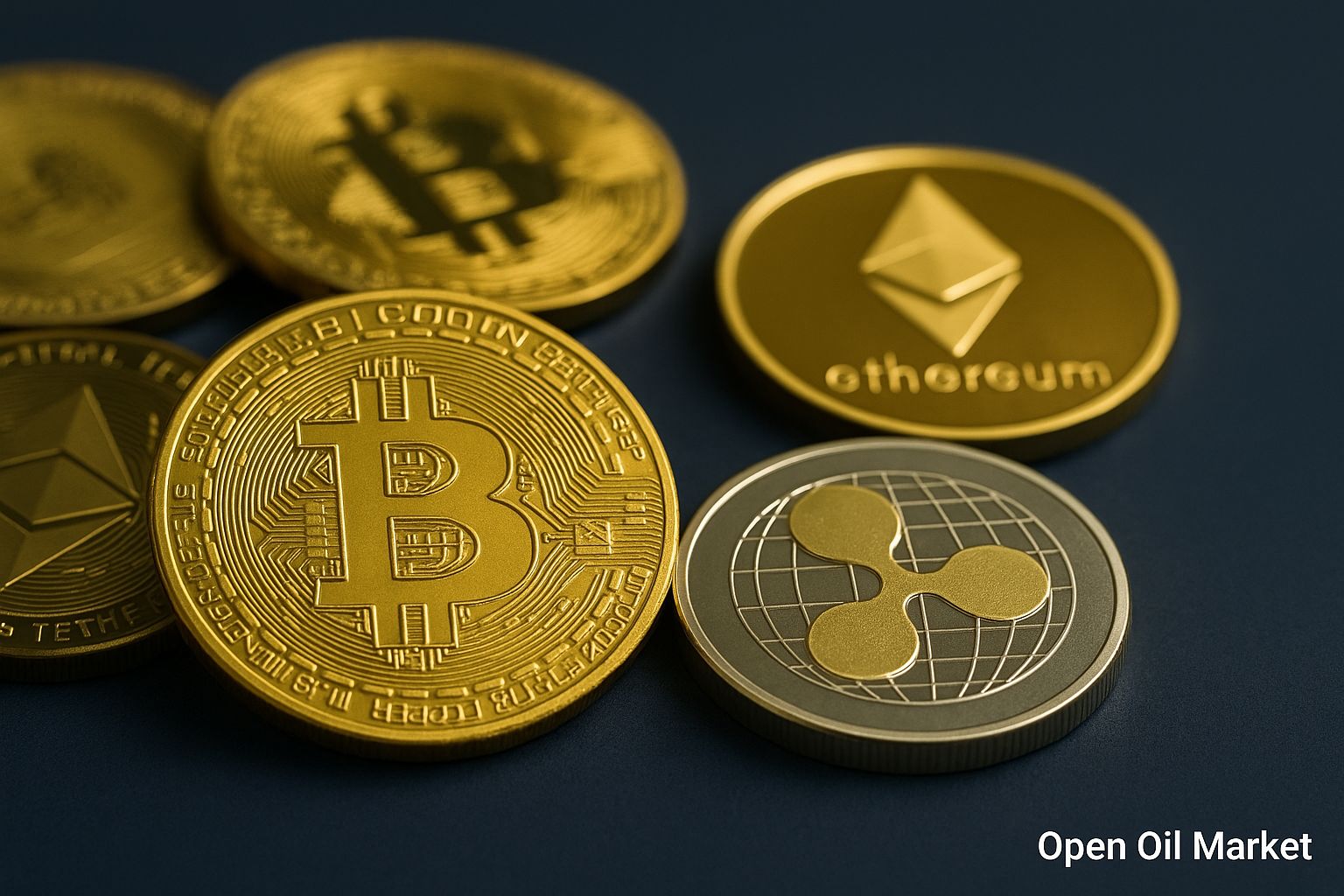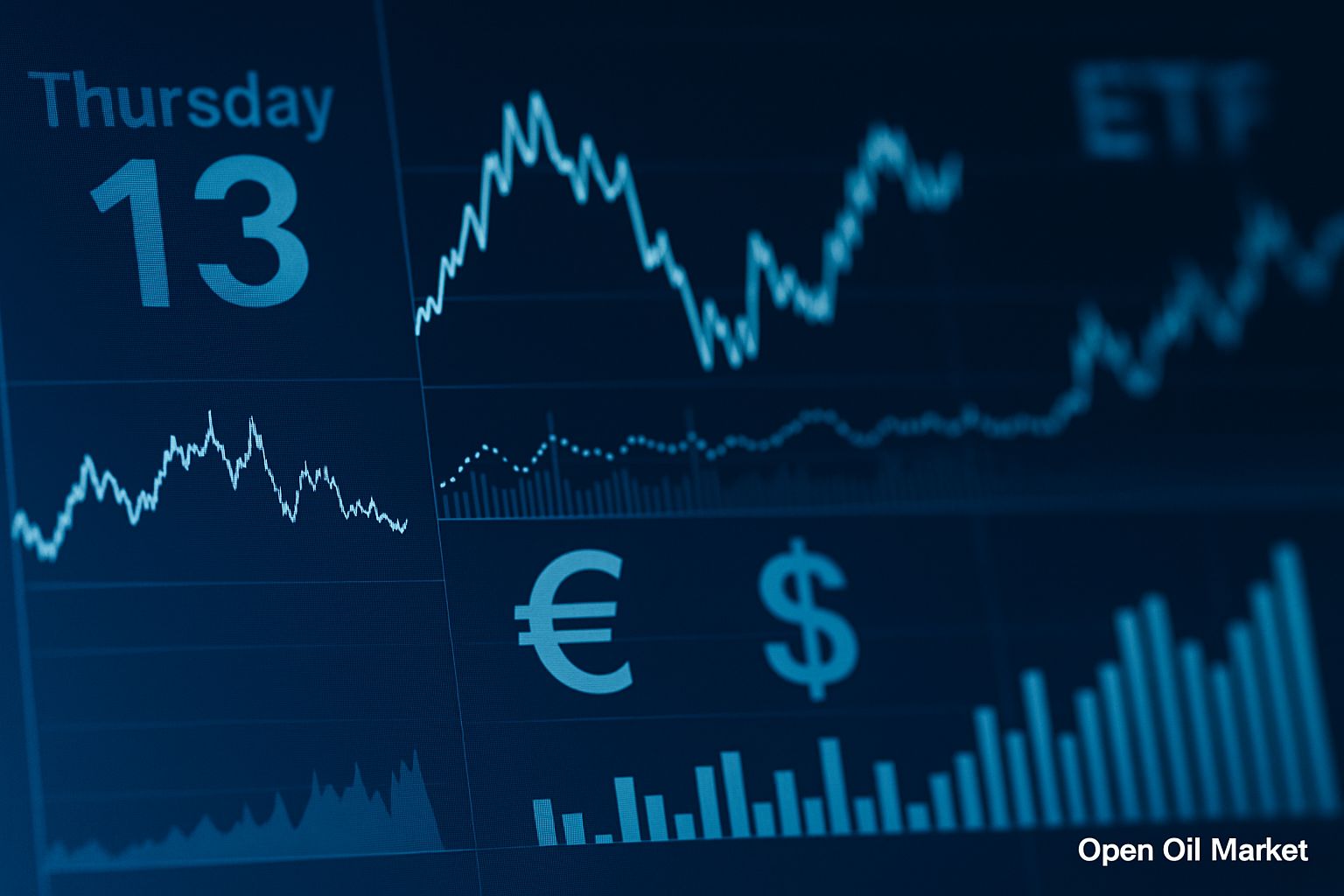
Current Cryptocurrency News as of 21 October 2025: Bitcoin Maintains Position Above $110,000 After Volatility, Ethereum Stays Around $4,000, Altcoins Resume Growth. Investor Sentiment Improves Amid Expectations of Fed Policy Easing; Overview includes Top 10 Cryptocurrencies, Institutional Trends, and Market Forecasts.
By the morning of 21 October 2025, the cryptocurrency market is showing a steady recovery following recent volatility. Bitcoin remains above the key mark of $110,000, having regained much of the losses from the previous week and supporting the growth of the total market capitalisation (over $3.5 trillion). Following Bitcoin, Ethereum and most leading altcoins are strengthening, with nearly all of the top 10 digital assets trading in the "green zone." Investors, including institutional players, are gradually returning to the market amid improved sentiment, interest in new crypto ETFs, and a favourable regulatory environment.
Bitcoin Stabilises After Spikes of Volatility
The flagship of the crypto market, Bitcoin (BTC), as of 21 October, is consolidating around the $110,000–$112,000 range, holding its position after the sharp spike and subsequent correction earlier in the month. In the first week of October, Bitcoin updated its historical maximum, exceeding around $125,000 amid the "Uptober" effect and a surge of capital inflow. However, unexpected news—specifically, the announcement by the US regarding 100% tariffs on imports from China—triggered a brief "flash crash," with BTC's price plummeting nearly 15%, dropping to just above $100,000 before finding support. Nevertheless, by mid-month, Bitcoin had recovered most of the dip and climbed back above $110,000, confirming its resilience. The current price is approximately 2–3% below its peak values but significantly higher than levels seen in the previous month; since the beginning of the year, BTC has risen by around 45%, outperforming most traditional assets. The market capitalisation of Bitcoin is currently estimated at approximately $2.2–$2.3 trillion, accounting for about 60% of the total cryptocurrency market capitalisation.
Despite recent fluctuations, the fundamental factors for Bitcoin remain positive. The US Federal Reserve is signalling a readiness to ease monetary policy: recent speeches by Fed officials have strengthened expectations of a rate cut at the upcoming meeting in late October. The prospect of cheaper money supports demand for "digital gold" among investors. Additionally, the US maintains a crypto-friendly environment—the administration continues to support the industry, having previously allowed Bitcoin to be included in 401(k) retirement plans and initiated the creation of a state crypto reserve. Institutional inflows are also providing additional momentum to the market; for instance, the first Bitcoin spot ETF in the US (from BlackRock), launched at the beginning of the month, attracted over $1.5 billion in investments in its first weeks, demonstrating strong appetite from major players. Some public companies have also taken advantage of the price drop: for example, mining firm Marathon Digital Holdings reported purchasing around 400 BTC last week, which market participants interpreted as a sign of confidence. Experts note that Bitcoin's robust recovery after the crash has enhanced traders' and investors' trust: many see the recent dip merely as a technical pause within an ongoing bullish trend. Major investment banks (JPMorgan, Standard Chartered, and others) continue to hold optimistic forecasts, anticipating Bitcoin's price to rise to $150,000–$200,000 by the end of the year, assuming a favourable macroeconomic environment.
Ethereum and Leading Altcoins
The second-largest crypto asset, Ethereum (ETH), is also exhibiting stability and a gradual recovery. The price of Ethereum is once again holding above the psychologically significant level of $4,000, currently fluctuating in the range of $4,050–$4,100, approximately 15% below its recent peak. In the initial days of October, ETH followed Bitcoin's lead, rising to around $4,900, updating its historical maximum for the first time in four years (the previous record of $4,890 was set in November 2021). Following this, Ethereum corrected alongside the broader market, dropping by approximately 15%, but managed to stabilise around the $4,000 mark, thereby retaining most of its previous gains. The current capitalisation of Ethereum is around $500 billion (≈13% of the market), reinforcing its status as the largest altcoin.
Demand for Ethereum is supported by fundamental factors. The Ethereum blockchain remains a key platform for the decentralised finance (DeFi) ecosystem, NFTs, and numerous dApps, thus sustaining interest in ETH even during market fluctuations. Investors are also optimistically looking at anticipated technological upgrades to the network. A planned protocol upgrade for Ethereum (codenamed "Fusaka") aimed at improving scalability and network security is set to take place in the coming weeks, which is expected to reduce fees and enhance throughput. Furthermore, rumours are circulating in the market that the Securities and Exchange Commission (SEC) is close to approving the first spot ETF for Ethereum—this could happen within the current quarter, acting as a strong driver for ETH. Institutional interest in Ethereum is also evident: the open interest in Ethereum futures on the Chicago Mercantile Exchange (CME) reached a record level at the beginning of the month (equivalent to over $11 billion), and funds focused on Ethereum are attracting increased attention from investors. Collectively, these factors point to strong confidence among major players in Ethereum's long-term potential, despite short-term fluctuations.
Among other leading digital coins, Binance Coin (BNB), the proprietary token of the largest cryptocurrency exchange Binance, stands out. In October, BNB experienced sharp price swings: after setting a record (over $1,300 at the beginning of the month), the token fell to around $860 during the sell-off but then quickly rebounded. Currently, BNB is trading around $1,150 per coin, only slightly below its historical maximum. Despite ongoing legal and regulatory challenges surrounding Binance, BNB confidently remains in the top 5 due to its wide range of applications: it is used to pay trading fees, participate in initial token offerings, stake, and in various DeFi services within the BNB Chain ecosystem.
XRP, the token of the Ripple payment network for cross-border settlements, is also holding its position. XRP is now consolidating around $2.50, having gained more than double since the start of the year. In 2025, XRP experienced significant rallies due to Ripple's legal victory over the SEC in the US: the court confirmed that trading XRP does not violate securities laws, removing regulatory uncertainty. This legal clarity has restored investor confidence and allowed XRP to re-enter the top five cryptocurrencies by market capitalisation (~$140 billion). Despite the recent corrections from peaks of around $3, the Ripple token continues to enjoy heightened demand, remaining one of the key assets in the blockchain payment solutions sector.
Altcoin Market: Solana, Cardano, and Others
The broader altcoin market is generally showing synchronous improvement alongside Bitcoin and Ethereum. Solana (SOL), one of the fastest-growing platforms for smart contracts, is holding around the $190–$200 range, demonstrating relative stability. Just a week ago, SOL was falling behind the market, but with the return of activity in DeFi applications based on Solana, its price has rebounded dramatically. Interest in SOL is further fueled by expectations that Solana could be the next cryptocurrency to receive approval for a spot ETF in the US. If a SOL ETF is approved, Solana will become the first protocol after BTC and ETH to have its own fund in the traditional market—this will attract even more institutional attention to the coin. Moreover, the Solana ecosystem continues to develop dynamically: new DeFi platforms and NFT marketplaces are being launched, increasing the fundamental value of SOL in the long term.
Another notable altcoin is Cardano (ADA), a blockchain platform developed with a scientific approach. ADA is currently trading around $0.68, stabilising after sharp fluctuations in previous months. Earlier, amid rumours of an ETF launch, Cardano's price surged nearly to $1.00 but then corrected by 30% from those peaks. Nonetheless, interest in the Cardano project remains high: the team continues to implement technological upgrades (for instance, the scalability protocol Hydra), and the extensive community of supporters believes in the long-term growth of the ecosystem. Many ADA holders anticipate that improvements in network specifications and a potential launch of investment products based on Cardano will help the token reach new highs over time.
Among the largest cryptocurrencies by market capitalisation, diverse projects such as Dogecoin and Tron remain. The meme cryptocurrency Dogecoin (DOGE), originally created for fun, is nonetheless trading around $0.18–$0.20 and maintains its position among the market leaders. Despite a more than 20% drop at the beginning of October, DOGE quickly recovered thanks to its dedicated community and periodic celebrity attention. The volatility of this coin remains high, but investor interest in the "meme" asset remains remarkably robust, allowing Dogecoin to stay in the top 10. The Tron (TRX) platform, aimed at decentralised entertainment and Web3, is trading around $0.30–$0.32. TRON is particularly popular in Asia, and its ecosystem attracts users with staking possibilities and low fees. Notably, a significant portion of the stablecoin USDT is issued on the Tron blockchain, ensuring a high demand for TRX for transactions. The presence of Dogecoin and Tron among the leaders emphasises the variety of the crypto industry: alongside high-tech platforms, investors value niche projects aimed at community engagement and specific applications.
Institutional Trends: Cautious Optimism Returns
In the mid-autumn period, the behaviour of large institutional investors in the crypto market reflects cautious optimism. On the one hand, the recent volatility has encouraged some players to lock in profits: last week saw outflows of funds from several crypto ETFs. According to industry analysts, the total net capital outflow from Bitcoin spot funds in the US amounted to about $1.2 billion, and from Ethereum ETFs—around $300 million (partially due to price corrections and position reallocations). These figures indicate that some investors have temporarily reduced their risks amid the price collapse.
On the other hand, strategic interest from large capital in cryptocurrencies does not weaken; on the contrary, it continues to grow. In 2025, American regulators have already approved several spot exchange-traded funds for digital assets, significantly simplifying institutional investors' access to the crypto market. New ETFs for some leading altcoins, including Solana and XRP, are expected to receive approval by the end of the year. The emergence of such products will expand opportunities for conservative investors to invest in cryptocurrencies through familiar exchange instruments.
The integration of cryptocurrencies into the traditional financial system is also ongoing. Major banks and fintech companies worldwide are announcing new services related to digital assets. In the US, several fintech banks (e.g., Brex) have begun supporting transactions in stablecoins like USDC for their clients, while some regional banks are experimenting with issuing their own stablecoins to expedite interbank payments. In the European Union, the comprehensive regulatory package MiCA came into effect this summer, establishing clear rules for the crypto industry; in Hong Kong, licensing for stablecoin providers has been introduced—these steps worldwide increase trust in the industry and attract institutional players. Overall, despite the short-term fluctuations in the market, major financial players are not pulling back from their crypto projects. Instead, there is an acceleration in investments in blockchain startups and infrastructure; the corporate sector views distributed ledger technologies as one of the drivers of future growth. Thus, although temporarily, some funds were withdrawn from cryptocurrencies due to heightened volatility, the strategic interest of institutions in digital assets remains a rising trend.
Market Sentiments and Volatility
The sharp price fluctuations in early October significantly affected market participants' sentiments, but the situation is gradually stabilising. Just a week ago, the "Fear and Greed Index" for cryptocurrencies had dropped into the "extreme fear" zone amid panic sales—such was the shock from the sudden price collapse. However, as prices began to recover, the index rebounded: it is now positioned around 45 points out of 100, which, while still corresponding to a "fear" mode, is significantly better than recent lows. One could say that the euphoria of the start of the month has dissipated completely, yet the extreme panic is behind, with investor sentiments gradually shifting towards neutrality.
The volumes of forced liquidations on derivative crypto exchanges have also decreased to average levels. During the height of the downturn on 10–11 October, positions worth a record ~$19 billion were liquidated (affecting over 1.5 million traders), while in recent days exchanges are forcibly closing only hundreds of millions of dollars a day. This indicates that the market has shed a significant portion of excessively risky and over-leveraged positions, and the pressure from margin calls has eased. Experts note that such a "cleaning" process of excessive leverage can be healthy for the market: the removal of overheated speculative positions lays a stronger foundation for future growth.
Nevertheless, market participants should still be prepared for increased volatility. Geopolitical factors—such as the escalation of trade disputes between the US and China—can trigger a new wave of price fluctuations in risk assets at any moment. Furthermore, crucial events are still pending that the crypto community is closely monitoring: decisions by central banks on interest rates, the release of macroeconomic data, and potential regulatory announcements. Any surprises on these fronts could either accelerate a new rally or provoke another wave of correction. In the short term, the market is likely to continue alternating between periods of growth and pullbacks as it digests news; however, in the absence of new shocks, the underlying optimism among investors remains.
Forecasts and Expectations
Despite recent fluctuations, many analysts maintain a positive outlook for cryptocurrencies through the end of 2025. The overall bullish sentiment is reinforced by expectations of imminent easing in monetary policy: if the US Fed indeed proceeds to cut interest rates, this could spur a new influx of capital into high-yield assets—including Bitcoin and Ethereum. Several investment companies have raised their price targets in October: some forecasts from major banks suggest Bitcoin could rise to $150,000–$180,000 within the next 3–6 months. For Ethereum, optimistic scenarios foresee movement towards levels of $6,000 and above, especially with a successful ETF launch and the implementation of network technological updates.
However, conservatively inclined experts caution that the path to new peaks may be uneven. Following such a powerful rally, repeated spikes in volatility are possible, especially as Bitcoin's price approaches psychologically significant levels (for instance, $130,000 and $150,000). In the event of worsening geopolitical circumstances or delays in reducing rates, the market could enter a prolonged flat or deepen its correction. Nevertheless, historical experience shows that every deep dip in the crypto market is eventually followed by a new growth cycle. Investors are advised to adhere to risk management principles: diversify their portfolios, avoid excessive leverage, and not succumb to emotions during panic sales. The crypto sector still possesses strong fundamental growth drivers—and assuming a favourable macro environment, many specialists expect the market to end the year on a positive note, updating historical maxima.
Top 10 Most Popular Cryptocurrencies
As of the morning of 21 October 2025, the following cryptocurrencies are included in the top 10 largest and most popular digital assets by market capitalisation:
- Bitcoin (BTC) – the first and largest cryptocurrency, acting as the equivalent of "digital gold." BTC is trading around $111,000, remaining close to its record values. Bitcoin's capitalisation exceeds $2.2 trillion (about 60% of the total market), and it continues to set the tone for the dynamics of the crypto market.
- Ethereum (ETH) – the second-largest crypto asset and the primary platform for smart contracts, DeFi, and NFTs. ETH is priced at approximately $4,100, slightly below its historical peak (~$4,900). The market value of Ethereum is around $500 billion (≈13% of the market). Ethereum is actively evolving to enhance scalability, which supports long-term investor interest.
- Binance Coin (BNB) – the exchange token of the largest cryptocurrency exchange Binance and the native coin of the BNB Chain ecosystem. The current price of BNB is around $1,150. In October, the token updated its maximum (~$1,300) and remains in the top 3 due to its wide range of applications (paying fees, participating in DeFi, etc.). The market capitalisation of BNB is estimated at around $170–$180 billion.
- Tether (USDT) – the largest stablecoin pegged to the US dollar at a 1:1 ratio. USDT is widely used for trading and settlements on cryptocurrency exchanges. Its price is maintained at $1.00 (≈80 ₽), and its capitalisation stands at around $160–$170 billion. USDT plays a critically important role in the ecosystem, providing liquidity and hedging against risks.
- XRP (Ripple) – the token of the Ripple payment platform for cross-border transfers. XRP is trading around $2.50; in terms of capitalisation (~$140 billion), it has secured its place among the market's top five. Ripple's success in court against the SEC eliminated the uncertainty surrounding XRP, which boosted investor confidence. The token remains one of the key assets in the global payments space.
- Solana (SOL) – a high-performance blockchain platform for decentralized applications. SOL is priced around $190 per coin (market cap ~ $90–100 billion), having recovered from its recent correction. Solana captures attention due to its scalability and ongoing ecosystem development, along with expectations for the launch of its own ETF, which supports its position in the top 10.
- USD Coin (USDC) – the second-largest stablecoin, backed by reserves of dollars (issued by Circle). The USDC rate is firmly pegged to $1.00, and its market capitalisation is around $65 billion. USDC is popular among institutional investors and in DeFi due to the transparency of reserves and regulation, playing an important role in trading and payment operations.
- Dogecoin (DOGE) – the most well-known "meme" cryptocurrency, created as a joke. DOGE hovers around $0.19 (capitalisation ~$28 billion) following a rollback from its September highs. The coin remains in demand due to its dedicated community and periodic mentions in the media. Despite its high volatility, Dogecoin continues to make its way into the top 10, demonstrating remarkable resilience in investor interest.
- Cardano (ADA) – a smart contract platform developed with a research-driven approach. ADA is trading around $0.68 (capitalisation ~$25 billion) following a correction from its recent highs near $1.00. The project attracts attention for its planned technological upgrades and the potential launch of ADA-based ETFs. An active community and improvements in technology support the long-term prospects for Cardano.
- TRON (TRX) – a blockchain platform for creating decentralized applications and digital entertainment, especially popular in Asia. TRX is priced around $0.32; its market capitalisation is estimated at approximately $30 billion. TRON is known for the extensive use of its network for the issuance of stablecoins (a significant portion of USDT operates on Tron) and staking opportunities, ensuring stable demand for the token. The project continues to develop its Web3 ecosystem, retaining its place among market leaders.
The Cryptocurrency Market on the Morning of 21 October 2025
- Major Cryptocurrency Prices: Bitcoin (BTC) — $111,000; Ethereum (ETH) — $4,050; XRP — $2.50; BNB — $1,130; Solana (SOL) — $190; Cardano (ADA) — $0.68.
- Market Indicators: Total cryptocurrency market capitalisation ≈ $3.8 trillion; Bitcoin dominance ≈ 59–60%; Fear and Greed Index = 45 (zone of "fear," an improvement compared to last week).
- Leading Changes in 24 Hours: Growth – Synthetix (SNX) +20%; Decline – Myx Finance (MYX) -7%.
- Analysis: Bitcoin and Ethereum are consolidating around current levels following turbulent trading, indicating relative market calm. The sentiment index, while still in the fear zone, has significantly lifted from extreme values—panic sentiments have subsided, and investors have taken a wait-and-see approach. The top gainer is the token of the DeFi protocol SNX, which has attracted attention with a sharp daily spike—this indicates local interest in altcoins amid the overall recovery. The 7% decline in MYX reflects a targeted profit-taking strategy on low-liquidity assets following a recent rally. Overall, the cryptocurrency market demonstrates resilience: key metrics remain healthy, and investor interest is gradually returning. This creates a solid foundation for a potential new rally after the consolidation phase if external conditions remain favourable.




